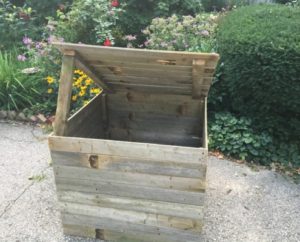By Monica Elliott
Turning the compost is Andy’s favorite job on the farm. He told me he doesn’t know why, other than it “feels productive.”
Honestly, I don’t get it.
I’m sure the high school helpers agree with me, after their very first day on the farm was spent pulling weeds from the huge piles and shoveling it into wheelbarrows.
I overheard them complaining about the smell.
“It smells like POOP.”
“This is disgusting!”
While it’s true that theres’ nothing glamorous about the work of composting, and a southern breeze can make the whole farm smell downright nasty, I have a new appreciation for the stuff after the composting session we attended.
Here’s a few tidbits we learned:
What is compost?
Compost is a nutrient-rich soil additive made from old plant matter. It’s food (and other) scraps recycled into something like a fertilizer.
How does it work?
The secret is millions of little microorganisms that help break down the decomposing food. Most of these are bacteria, but they’re also helped by beetles, mites, and everyone’s favorite: worms. Composting depends on creating the conditions that foster microorganism activity so these little helpers can do the real work.
Can you do it at home?

Yes! I learned it’s super easy for anyone to start a compost pile. All you need is a good spot, a simple container, and a shovel/pitchfork to help you turn it. As long as you mix it regularly (every 2-3 weeks) and keep it in a place that gets frequent sunshine, your food and lawn waste should break down in no time! On the right is an example of a home compost container made from reclaimed wood—these are made by our guest lecturer and local Master Composter, Ken Freestone.
What makes a healthy compost pile?
The key to happy compost is keeping the microorganisms happy; this requires a good balance of heat, air, water, and ingredients. Consistent sunshine, regular mixing, and occasional watering will create an environment where the inside of the pile is warm, moist, and well-oxygenated—the perfect environment for the microbacteria to their job. The last step is to watch what you feed them. Compost needs a good mix of “greens” and “browns.” The greens are the nitrogen-rich food scraps—any vegetable, fruit, or grain can be composted, but stay away from meat and dairy. Also, when it’s fresh, lawn waste such as grass clippings is considered green. Things like dead leaves, sticks, sawdust, and even coffee grounds are the browns; these are full of carbon which is necessary to feed the microorganisms, and also can soak up some moisture. With all these things are all in balance, the process is still rather slow, but after a couple months, the end result will be some nice, beautiful, broken-down compost!
This process reminds me of waiting on the Lord. Our responsibility is creating a heart-environment that’s responsive and conducive to His presence, but we don’t do the real work—He does. We just wait for our scraps, our meager offerings, to be turned into something rich and life-giving.
Compost is a resurrection process. From death, the Lord brings forth new life. The compost is spread and shared all over the farm, where it gives nutrients to all types of plants. In a way, it’s a reminder of a Revelation promise—“Behold, He is making all things new.”
I guess I see now what Andy likes about it.

Recent Comments